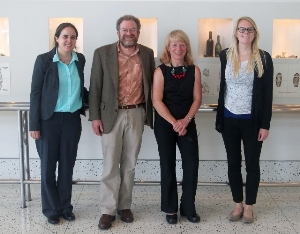Sep 3 2014
Scientists, including University of Oregon chemist Geraldine Richmond, have tapped oil and water to create scaffolds of self-assembling, synthetic proteins called peptoid nanosheets that mimic complex biological mechanisms and processes.
 Co-authors, from left, Proulx, Zuckermann, Richmond and Robertson
Co-authors, from left, Proulx, Zuckermann, Richmond and Robertson
The accomplishment -- detailed this week in a paper placed online ahead of print by the Proceedings of the National Academy of Sciences -- is expected to fuel an alternative design of the two-dimensional peptoid nanosheets that can be used in a broad range of applications. Among them could be improved chemical sensors and separators, and safer, more effective drug-delivery vehicles.
Study co-author Ronald Zuckermann of the Molecular Foundry at Lawrence Berkeley National Laboratory (LBNL) first developed these ultra-thin nanosheets in 2010 using an air-and-water combination.
"We often think of oil on water as something that is environmentally bad when, in fact, my group over the past 20 years has been studying the unique properties of the junction between water and oil as an interesting place for molecules to assemble in unique ways -- including for soaps and oil dispersants," said Richmond, who holds a UO presidential chair. "This study shows it is also a unique platform for making nanosheets."
Lead authors on the project were Ellen J. Robertson, a doctoral student in Richmond's lab at the time of the research, and Gloria K. Oliver, a postdoctoral researcher at LBNL. Robertson is now a postdoctoral researcher at LBNL.
Work in Richmond's lab helped to identify the mechanism behind the formation of the nanosheets at an oil-water interface.
"Supramolecular assembly at an oil-water interface is an effective way to produce 2D nanomaterials from peptoids because that interface helps pre-organize the peptoid chains to facilitate their self-interaction," said Zuckermann, a senior scientist at LBNL's Molecular Foundry in a news release. "This increased understanding of the peptoid assembly mechanism should enable us to scale-up to produce large quantities, or scale- down, using microfluidics, to screen many different nanosheets for novel functions."
Zuckermann and Richmond are the corresponding authors on the paper. Additional co-authors are Menglu Qian and Caroline Proulx, both of LBNL.
Like natural proteins, synthetic proteins fold and conform into structures that allow them to do specific functions. In his earlier work, Zuckermann's team at LBNL's Molecular Foundry discovered a technique to synthesize peptoids into sheets that were just a few nanometers thick but up to 100 micrometers in length. These were among the largest and thinnest free-floating organic crystals ever made, with an area-to-thickness equivalent of a plastic sheet covering a football field.
"Peptoid nanosheet properties can be tailored with great precision," Zuckermann says, "and since peptoids are less vulnerable to chemical or metabolic breakdown than proteins, they are a highly promising platform for self-assembling bio-inspired nanomaterials."
To create the new version of the nanosheets, the research team used vibrational sum frequency spectroscopy to probe the molecular interactions between the peptoids as they assemble at the oil-water interface. The work showed that peptoid polymers adsorbed to the interface are highly ordered in a way that is influenced by interactions between neighboring molecules.
The substitution of oil in place of air creates a raft of new opportunities for the engineering and production of peptoid nanosheets, the researchers said. The oil phase, for example, could contain chemical reagents, serve to minimize evaporation of the aqueous phase or enable microfluidic production.